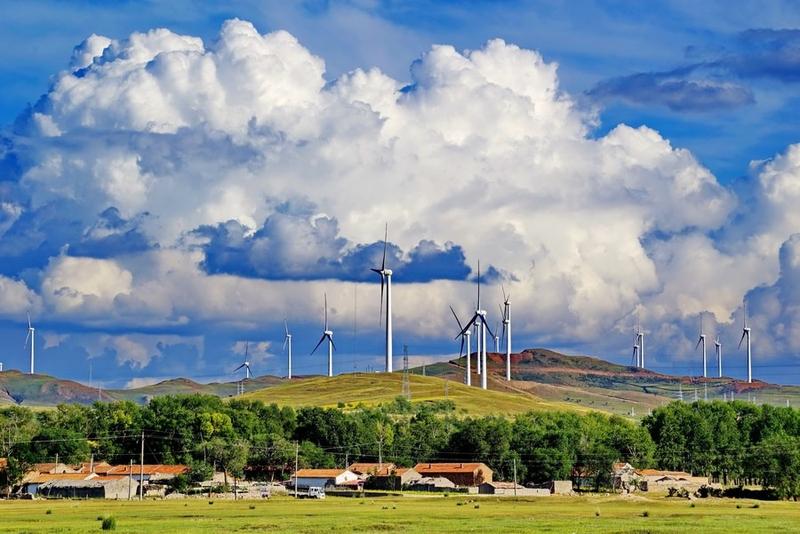 The file photo shows a wind power plant in Zhangjiakou, North China's Hebei province. (PHOTO / XINHUA)
The file photo shows a wind power plant in Zhangjiakou, North China's Hebei province. (PHOTO / XINHUA)
Last year, as the pandemic forced millions to stay indoors, off the roads, and out of workplaces, the planet stopped to catch its breath for the first time in more than seven decades.
Widespread disruptions in the transport sector were responsible for the majority of this dip in carbon emissions
A stall in the rapacious pace of human movement and development saw global emissions in 2020 fall by 2.6 billion tons from the previous year, with a 7-percent decline being steeper than in any year since the end of World War II.
But this reduction is likely to be temporary, according to the Global Carbon Project, which released the data last week. Widespread disruptions in the transport sector were responsible for the majority of this dip in emissions, and climate scientists say that major action must be taken by all nations in order to prevent CO2 levels from rebounding and even eclipsing pre-pandemic levels as countries emerge from lockdowns.
For its part, the Chinese leadership announced a pair of ambitious targets toward the end of last year, committing to lowering carbon dioxide emissions per unit of gross domestic product, or carbon intensity, by at least 65 percent by 2030, and aiming for carbon neutrality by 2060.
ALSO READ: Proposal sets path to green growth
During the two sessions-the annual gatherings of China's top legislature, the National People's Congress, and the top political advisory body, the Chinese People's Political Consultative Conference National Committee-China further sketched out a road map toward this green transition.
"We will ensure that China meets the targets for its intended nationally determined contributions in response to climate change by 2030," Premier Li Keqiang said in the 2021 Government Work Report. "We will expedite the transition of China's growth model to one of green development, and promote both high-quality economic growth and high-standard environmental protection."
Li confirmed that during the period of China's 14th Five-Year Plan (2021-25), energy consumption per unit of GDP and carbon dioxide emissions per unit of GDP will be reduced by 13.5 percent and 18 percent, respectively, while forest coverage will expand to 24.1 percent of China's total land area.
"That China continues its ambitions around climate and biodiversity I find is really very encouraging," Asher Minns, executive director of the Tyndall Centre for Climate Change Research at the University of East Anglia, told China Daily. "All policies and actions (are) to slow (emissions), while enhancing forests and ecosystems has an impact on everyone."
For those eager to hear further specifics about how China will achieve its emissions peaking and eventual neutrality, Li explained that more will be revealed in an action plan this year.
"We will draw up an action plan for carbon emissions to peak by 2030," Li said. "China's industrial structure and energy mix will be improved. While promoting the clean and efficient use of coal, we will make a major push to develop new energy sources, and take active and well-ordered steps to develop nuclear energy on the basis of ensuring its safe use."
Commitment welcomed
British economist Nicholas Stern, who is chair of the Grantham Research Institute on Climate Change and the Environment at the London School of Economics, welcomed China's continued commitment to the proliferation of renewable infrastructure, which he said is essential in order to lessen reliance on fossil fuels.
"China has already committed to a very large expansion of low-carbon power from nuclear and renewables, but remains highly dependent on fossil fuels, particularly coal," Stern told China Daily.
Stern said China has the opportunity to "promote a sustainable economic recovery" from the pandemic and to "accelerate its transition to high-quality development and growth", particularly in its cities.
READ MORE: Green industries play role in poverty reduction drive
"This would allow China to realize... ecological civilization within the period of the 14th Five-Year Plan," said Stern. "This would provide a clear demonstration of China's leadership and would put pressure on the other largest emitters, including the United States, to aim for more ambitious action on climate change."
Ajay Gambhir, who is a senior fellow at Imperial College London, said China is "making the right noises" on its green transition.
"More specific and detailed ambition beyond the current minus 65 percent emissions intensity by 2030 might be expected eventually," Gambhir told China Daily, while adding that "key questions remain" around the retirement of coal-fired power plants.


